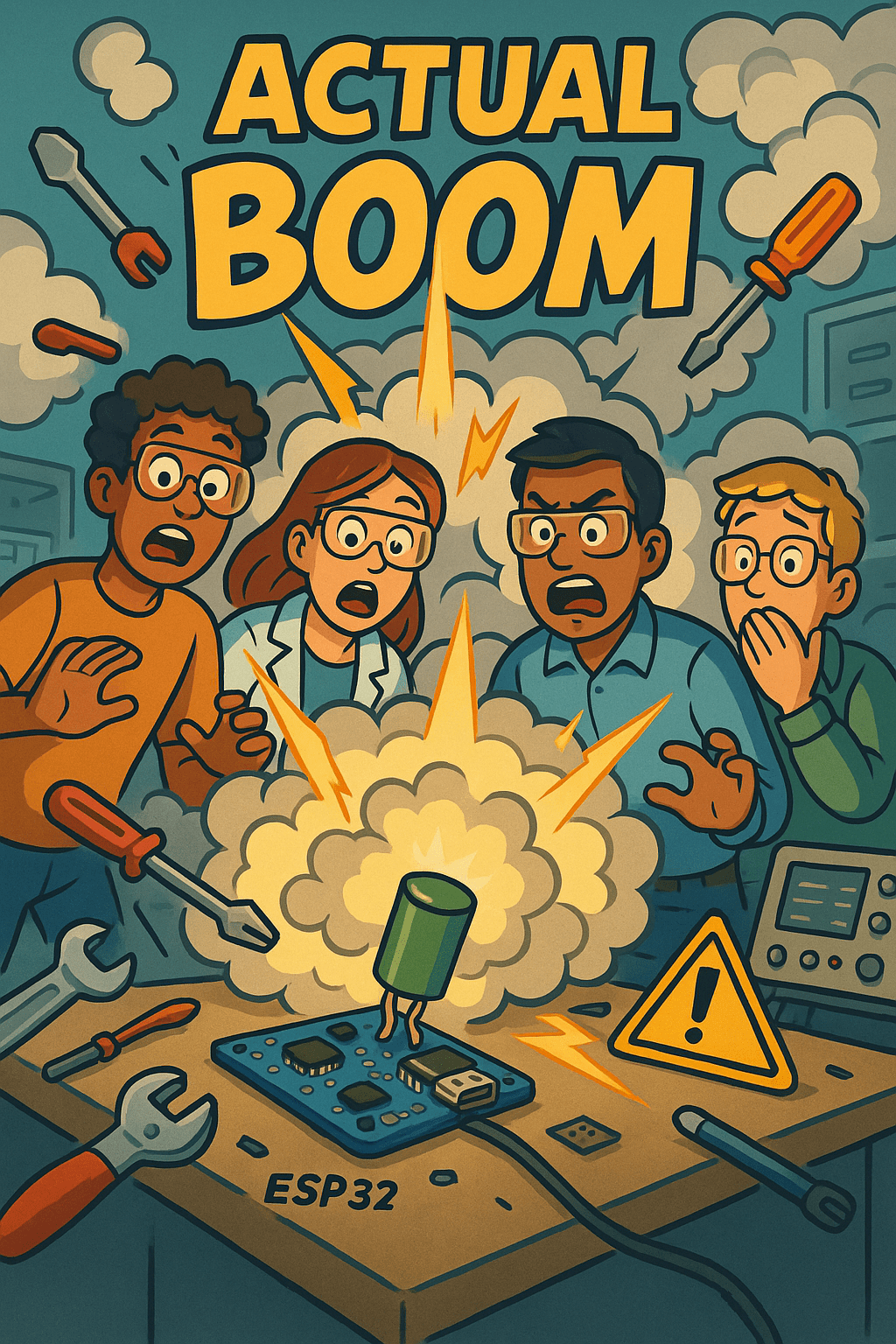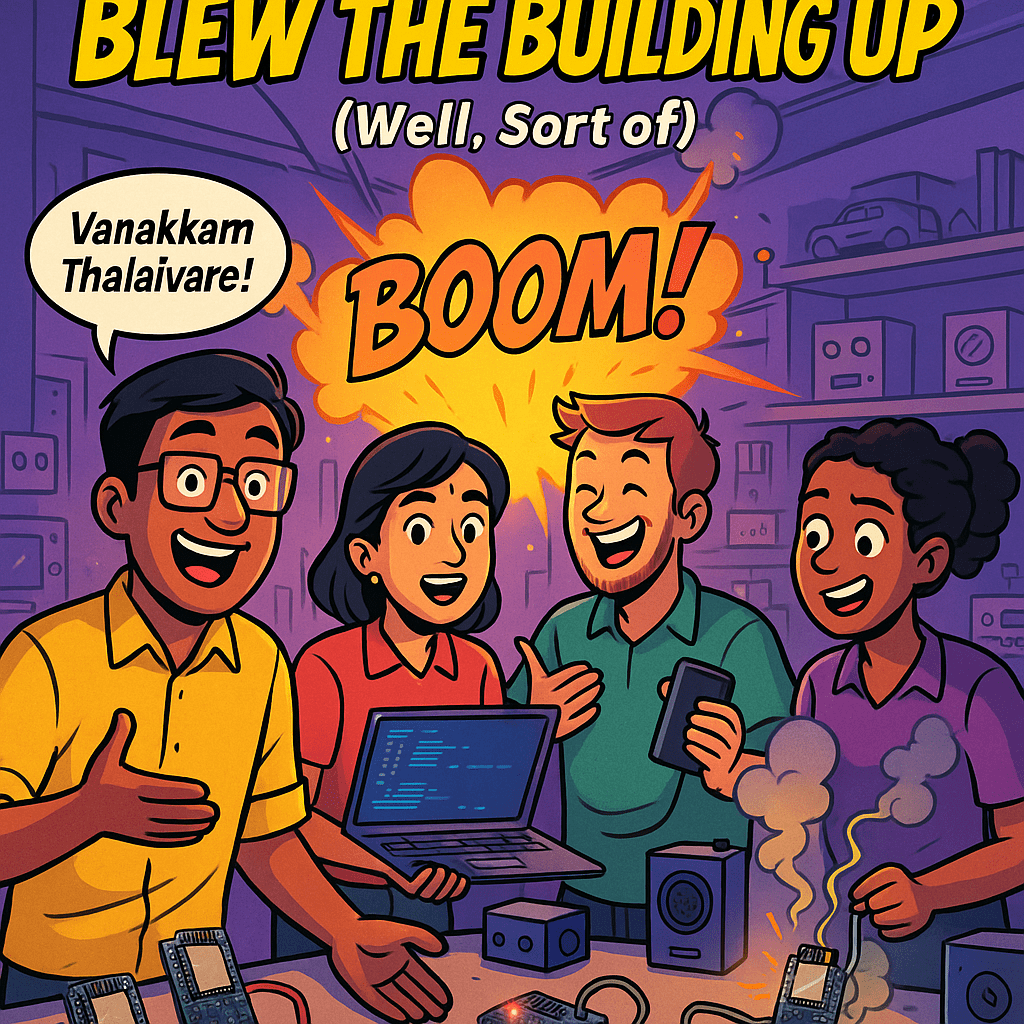The Acutally Boom -

Our ESP32 experiments started simple—just sending messages and blinking LEDs. But things got wild when curiosity pushed us to test capacitors with 240V!
Read Part 1 for the full story:

And now... the chaos continues in Part 2!
The Blast.
Our setup was halfway there—the button side was all set. Now, it was time to rig the other ESP32 to make the magic (or chaos) happen. We connected a relay to the second ESP, then hooked one end of the relay to a 240V input and the other to a capacitor leg. The remaining leg of the capacitor was tied to the other 240V wire.
The logic was simple:
Press the button on one ESP, the message "Vanakom Thalayivare" is received on the other ESP, the relay turns on, and boom—240V flows through the capacitor, causing it to blast.
Everything was ready. But then… fear crept in.
What if something went wrong? Our brains were like CPUs at 100% usage, overthinking every possible outcome. We even joked about getting expelled for blowing up a small capacitor. (Realistically, no, it wouldn’t do much—just a pop and maybe a current surge, but nothing too wild.)
Still, to be safe, we decided to remove the capacitor and use an Arduino Uno board instead. We nicknamed it the "test board." (It was, in fact, the first thing I ever burned after joining Inovus, so it held a special place in my heart. Proud moment, right? Well, sort of.) Anyway, I managed to light up all four LEDs on the Uno, which, for some reason, had never happened before. That alone was a mini victory.
With the capacitor swapped out for the Uno, we pressed the button. And voilà, the LEDs on the Arduino lit up.
We were thrilled. The setup was working exactly as we had hoped.
“Now it’s time for the real deal,” we thought, grinning with that classic evil smirk.
We swapped the Uno back out for the capacitor, and now, everything was set. Just as we were about to test it, everyone else in the lab had gathered back at Inovus. So, naturally, we called them over.
“We’re gonna blast it!” we announced.
And we did.
The capacitor popped just as expected. We were stoked—our first experiment was a success, and the whole thing was surprisingly satisfying.After that, our mentor told us that was enough for the day. No more explosions. We were happy with the result, so we nodded in agreement.
Mission accomplished.
Two Weeks of Calm… Then the RFID Plan
After the capacitor blast, we settled down for a couple of weeks, focusing on other things. But deep down, we still had this itch to set off another one. We’d have these fun conversations, plotting how to make the next blast even better (and maybe a little more dramatic). The best idea? Setting it off in some random spot, waiting for someone to walk by, and giving them the scare of their lives. Those talks—man, they were so satisfying.
Then one day, we had a thought: "What if we trigger the blast using an RFID card?". You know, like those fancy door locks that open when you swipe your card. But instead of opening a door, we’d trigger a blast when the card was read.
The plan was set. We got to work, updating the ESP with the button setup. We needed to add the RFID reader code, so if the card was correct, it would send the "Vanakom Thalayivare" message, and the rest would stay the same.
The code ran without errors—success! Now, we just had to wait for Saturday to set things off again.
The Big Blast
Saturday arrived. Unfortunately, that day the college was packed—staff, teachers, and all. But did we care? Nope. We set everything up anyway. First, we ran our tests with the "test subject" (our trusty Uno with the four lights). Everything worked like a charm.
We were feeling confident, so we swapped the Uno out for the capacitor, which we had desoldered from some old board. We gathered everyone around, hyping them up, and tapped the card on the reader.
Nothing.
We were like, "No way, that can’t be right." We tapped the card again. Still nothing.
That’s when we realized… the switchboard had no power. (Facepalm moment)
How foolish were we? We checked the connections and retried everything. Still nothing. We kept at it and eventually realized that the switchboard itself had lost power. Great. Something was off with the capacitor.
We swapped the capacitor for another one, tried again, and finally…
Boom!
It blasted—but this time, the whole floor was affected. The lights blinked for a moment. The switchboard we were using? Completely dead. Suddenly, everyone ran in, asking what happened. Even the office staff came by, demanding to know where the noise came from and why the lights were flickering. We stood there, feeling the weight of impending doom, thinking "Oh god, we are so screwed."
After a round of scoldings, things eventually calmed down. Thankfully, nothing too serious had happened, but we were still sad about blowing out three switchboards in the process.
In the end, though, it was a huge learning experience. We learned a lot about the power of a simple capacitor and how easily things can go sideways. Even after all this, we didn’t lose our spirit. Even after all the scoldings, we were already thinking about our next move. We realized that instead of relying on the regular power supply, next time we’d build our own custom circuit—something that could step up low power to high power for a more efficient blast.
Lessons Learned (Or Maybe Not?)
Looking back, we learned a lot that day. Not just about ESP32s or capacitors, but about what happens when curiosity meets overconfidence. Sure, we caused a mini power outage, but we also pushed the boundaries of what we thought we could do.
And hey, at least the ESP32s survived.
Next on the agenda? Maybe something less explosive. Or maybe not. After all, what’s life without a little risk?
Don’t try this without supervision or proper safety measures



